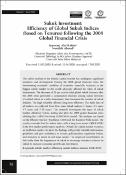Options
Sukuk Investment: Efficiency Of Global Sukuk Indices (based On Tenures) Following The 2008 Global Financial Crisis
Journal
Journal of Wealth Management & Financial Planning
Date Issued
2020
Author(s)
Syazwani Abd Rahim
Nursilah Ahmad
Abstract
The sukuk market in the Islamic capital market has undergone significant
evolution and development. During the 2008 global financial crisis, the
deteriorating economic condition of countries, especially Malaysia as the
biggest sukuk market in the world, adversely affected the value of sukuk
investments. The decrease of 33 per cent in total global sukuk issuance after
the 2008 crisis generated a complicated situation among sukuk investors
(classified sukuk as a risky investment), then increased the number of sukuk
defaults. The high volatility affected long-term efficiency. The daily data of
all indices are collected from Dow Jones Sukuk Indices (1-3years, 3-5 years,
5-7 years, and 7-10 years). This research investigates the types of sukuk
market efficiency before, during and after the 2008 global financial crisis
utilising the GARCH-in-Mean (GARCH-M) model. The analyses are based
on the Efficient Market Hypothesis (EMH) and the Random Walk model. The
results conclude that the sukuk index with a long-term tenure (DJSUK10TR)
is the best market performance analysis. Overall, the sukuk market record as
an inefficient market. In short, the findings will provide valuable information,
guidelines and give confidence to issuers, policymakers, regulatory bodies,
and investors to invest in and issue sukuk. The empirical contributions in
this study show the importance of sukuk to encourage investors to invest in
sukuk to increase economic growth and investment.
evolution and development. During the 2008 global financial crisis, the
deteriorating economic condition of countries, especially Malaysia as the
biggest sukuk market in the world, adversely affected the value of sukuk
investments. The decrease of 33 per cent in total global sukuk issuance after
the 2008 crisis generated a complicated situation among sukuk investors
(classified sukuk as a risky investment), then increased the number of sukuk
defaults. The high volatility affected long-term efficiency. The daily data of
all indices are collected from Dow Jones Sukuk Indices (1-3years, 3-5 years,
5-7 years, and 7-10 years). This research investigates the types of sukuk
market efficiency before, during and after the 2008 global financial crisis
utilising the GARCH-in-Mean (GARCH-M) model. The analyses are based
on the Efficient Market Hypothesis (EMH) and the Random Walk model. The
results conclude that the sukuk index with a long-term tenure (DJSUK10TR)
is the best market performance analysis. Overall, the sukuk market record as
an inefficient market. In short, the findings will provide valuable information,
guidelines and give confidence to issuers, policymakers, regulatory bodies,
and investors to invest in and issue sukuk. The empirical contributions in
this study show the importance of sukuk to encourage investors to invest in
sukuk to increase economic growth and investment.
Subjects
File(s)
Loading...
Name
Sukuk Investment_ Efficiency of Global Sukuk Indices (Based on Tenures) following the 2008 Global Financial Crisis.pdf
Size
7.25 MB
Format
Adobe PDF
Checksum
(MD5):baf0d9dc80ca80a1d2fdd0c8ee38f14e